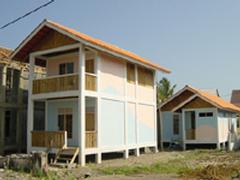Essay QuestionMAKING SOCIAL ARCHITECTUREQUESTION What do you believe is the most needed project in your town that, when built, would better the social situation for a population in need? Please fully and clearly describe the project and why you feel it is so important. In Stage One of the Competition, you will write a 500-word proposal that describes the project, the reasons for selecting the project, and an indication of how you as an undergraduate student might participate in making the project become a reality. In addition, from the list provided below, you are to select one of the 15 teams of architects, designers, and planners dedicated to the making of social architecture whom you believe would be the best suited to help you as a partner in developing your proposed project. For Stage One you will only list this team by name. If you are selected as a Semifinalist and invited to submit for Stage Two, you will be required to explain in detail the proposed project and why the commission for it should be awarded to the team of your choice. DISCUSSIONApplying social architecture ideals to built projects The current generation of architecture students is greeted with multiple new models and precedents for practice, ranging from the most traditional of corporate firms, to virtual offices, to nonprofit design organizations. Many examples of the latter—nonprofit design organizations—have their roots in the 1950s, 1960s, and 1970s. Renewed energy and interest in serving society and engaging communities, largely on the part of students and young professionals, has fueled a new breed of public interest pursuits. These new organizations and practices—which we are referring to generally as “teams”—are the focus for this year’s Berkeley Prize Competitions. There is a global framework in which making social architecture can and does occur today. This framework consists of the United Nations Millennium Project and the Millennium Development Goals which have as their primary aims: poverty reduction, the improvement of people’s lives, and environmental sustainability. 189 countries have signed on to the Goals, with the intention of achieving them by 2015-2020. Some teams see these goals as the context within which they work; others have much more site specific and limited goals. In either case, there are many possibilities for creating positive social change through design. Identifying a project As you embark on selecting a potential project in your community, and a team for you to partner with, it is critical to break outside the architect’s usual role as simply a problem-solver. You will need to look at the world in new ways and think proactively as a problem-identifier. Though rarely addressed or even encouraged to do so in school or practice, the skills acquired through architectural education and training give you unique perspective to identify social injustices—and potential design remedies. In identifying the population and project that you would like to focus on, consider the following questions:
For one example of how to select a project, see Charles Debbas's essay on Zimbabwe Childcare Centers. Selecting a team Having proven themselves unusually capable at making highly personal connections and commitments to the communities they serve, the teams profiled below have become important vehicles for public interest design, research, and advocacy.Despite small budgets, these teams’ shared desires to address ever-broadening social strata have impacted people and communities that might not otherwise have ever been touched by an architect. In making your team selection, consider the following questions:
You should become well informed about the team of your choice in thinking about your project proposal. Each team has a dedicated website, the link for which is provided below. Many also have books or articles written about their work. Out of respect for each team’s time, you are strongly discouraged from directly contacting representatives of your selected organization. Most of these teams are simply unequipped to respond to any volume of emails, phone calls, or other inquiries. As you embark on your career, we know that your research of these teams will demonstrate the fact that nonprofit design organizations are unique vehicles for tackling highly relevant and challenging social issues. Many of these organizations present incredible opportunities for designers to transform spaces into places and, in doing so, for designers to play a pivotal role in transforming the lives of communities and people. TEAM PROFILES(Select one team from the following fifteen options.)
Additional Help and InformationAre you in need of assistance? Please email info@berkeleyprize.org. |
|

